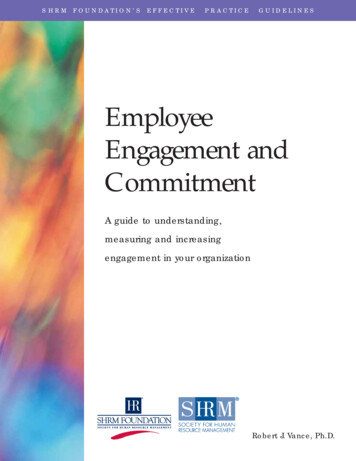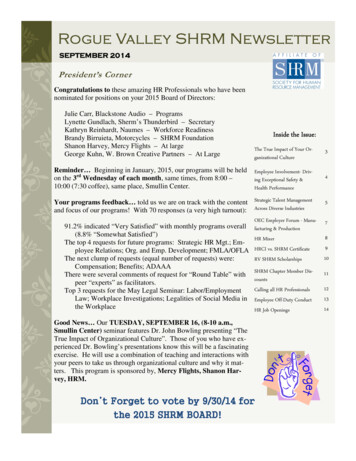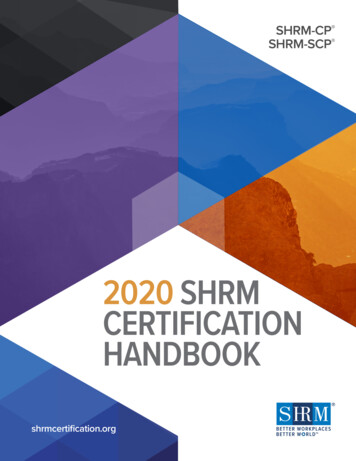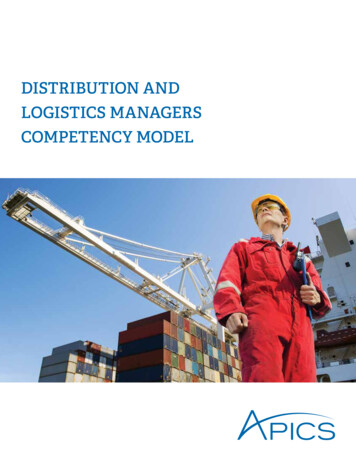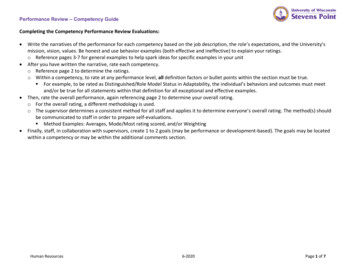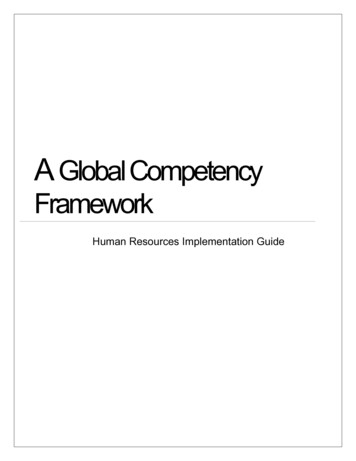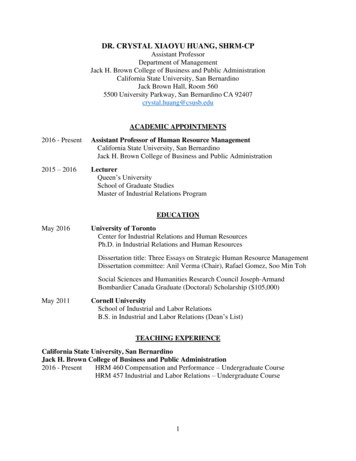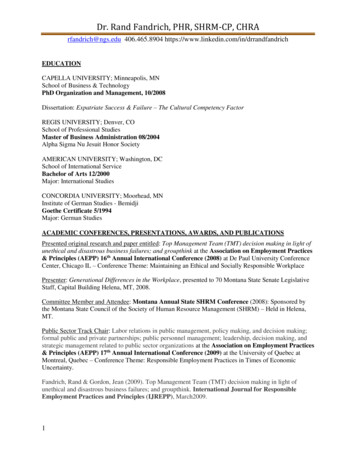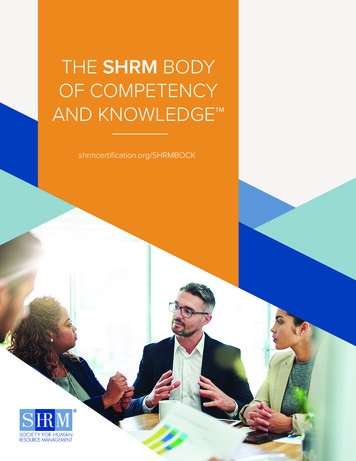
Transcription
THE SHRM BODYOF COMPETENCYAND KNOWLEDGE shrmcertification.org/SHRMBOCK
TABLE OF CONTENTSIntroduction to the SHRM Body of Competency and Knowledge. 1What Are Competencies?. 3Development of the SHRM BoCK.4New Material in the 2017 BoCK. 6Organization of the SHRM BoCK Document.7Section 1: Behavioral Competencies.7Section 2: HR Expertise.7Section 1: Behavioral Competencies. 8How to Read This Section. 8Leadership Cluster. 11Leadership & Navigation. 12Ethical Practice. 14Interpersonal Cluster. 17Relationship Management.18Communication. 20Global & Cultural Effectiveness.22Business Cluster.25Business Acumen.26Consultation.28Critical Evaluation.30Section 2: HR Expertise. 32How to Read This Section. 32People Knowledge Domain.35Functional Area #1: HR Strategic Planning.36Functional Area #2: Talent Acquisition.38Functional Area #3: Employee Engagement & Retention.39Functional Area #4: Learning & Development. 41Functional Area #5: Total Rewards. 42Organization Knowledge Domain.43Functional Area #6: Structure of the HR Function. 44Functional Area #7: Organizational Effectiveness & Development .45Functional Area #8: Workforce Management.46Functional Area #9: Employee & Labor Relations. 47Functional Area #10: Technology Management.49Workplace Knowledge Domain.51Functional Area #11: HR in the Global Context.52Functional Area #12: Diversity & Inclusion.53Functional Area #13: Risk Management.54Functional Area #14: Corporate Social Responsibility.56Functional Area #15: U.S. Employment Law & Regulations. 57Appendix A: Glossary. 59Appendix B: Resources. 69
SECTION1: BEHAVIORALTHE SHRM BODY OFCOMPETENCYAND COMPETENCIESKNOWLEDGEIntroduction to the SHRM Bodyof Competency and Knowledge For more than sixty-five years, the Society forHuman Resource Management (SHRM) hasserved the human resources (HR) profession.HR professionals worldwide look to SHRM forcomprehensive information and tools to helpthem perform effectively at their jobs, to developtheir careers, and to partner strategically withemployers. SHRM also works to advance the HRprofession as a whole, ensuring that as businesschanges, HR evolves to meet business needs.Increasingly, business leaders understand thateffective people management is a strategicimperative. As a result, employers expect HRprofessionals to demonstrate, in addition toa thorough knowledge of HR concepts andrequirements, the behavioral competenciesrequired to effectively apply that knowledgein the modern workplace in support oforganizational goals.In 2011, SHRM began a program of researchinvolving thousands of HR professionals toidentify the critical competencies needed forsuccess as an HR professional. This research ledto the development of the SHRM CompetencyModel, which defines eight key behavioralcompetencies (Ethical Practice, Leadership &Navigation, Business Acumen, RelationshipManagement, Communication, Consultation,Critical Evaluation and Global & CulturalEffectiveness) and one technical competency(HR Expertise). The SHRM Competency Modelprovides HR professionals with a comprehensiveroadmap for developing the capabilities theyneed to advance their careers and improve theireffectiveness in the workplace.The SHRM Body of Competency and Knowledge (SHRM BoCK ), which is based on the SHRMCompetency Model and illustrated in Figure 1,outlines the content of SHRM’s certificationexaminations, the SHRM Certified Professional(SHRM-CP ) exam for early-career and mid-levelpractitioners, and the SHRM Senior CertifiedProfessional (SHRM-SCP ) exam for senior-leveland executive practitioners. SHRM credentialsprovide reliable indicators to the global businesscommunity that the credential holder has thenecessary capabilities in both aspects of HRpractice—competencies and knowledge—thatare required for effective job performance.In addition to describing the behavioralcompetencies and technical knowledge testedon the SHRM-CP and SHRM-SCP certificationexams, the SHRM BoCK is also the commonframework for individuals developing examquestions (item writers), as well as individualsand organizations developing exam preparationmaterials. SHRM’s own operations for examdevelopment are separate and independent fromits operations for study material development.SHRM observes a strict firewall between theseactivities to protect the integrity and credibility ofthe certification exams.THE SHRM BODY OF COMPETENCY AND KNOWLEDGE1
THE SHRM BODYBODY OFOF COMPETENCYCOMPETENCYANDANDKNOWLEDGEKNOWLEDGEFIGURE 1: SHRM Body of Competency and Knowledge (SHRM BoCK)2THE SHRM BODY OF COMPETENCY AND KNOWLEDGE
INTRODUCTIONWhat Are Competencies?A competency is a group of highly interrelated knowledge, skills, abilities and other characteristics (KSAOs) thatgive rise to the behaviors needed to perform a given job effectively. For example, Critical Evaluation, one of thebehavioral competencies in the SHRM Competency Model, describes a group of KSAOs that include knowledge ofresearch design, critical thinking skills and deductive reasoning abilities. These highly interrelated KSAOs enableHR professionals to collect, compile, analyze and interpret job-relevant data and information for the purpose ofsupporting the HR function in their organizations.A set of competencies that collectively defines the requirements for effective performance in a specific job,profession or organization may be called a competency model.Competencies can be either technical or behavioral. Technical competencies reflect the knowledge specific toa given profession that is required for a professional in that field to perform a particular role. The HR Expertisecompetency in the SHRM Competency Model describes the technical knowledge specific to the HR field (such asthat associated with talent management, recruiting, or compensation and benefits).Behavioral competencies, on the other hand, describe the KSAOs that facilitate the application of technicalknowledge to job-related behaviors. They are more general in their applicability than the profession-specifictechnical competency of HR Expertise. For example, the behavioral competency Communication describes theKSAOs needed to effectively communicate across a range of media (e.g., e-mail and oral presentations) and with avariety of audiences (e.g., internal and external stakeholders).In sum, technical competencies reflect what knowledge HR professionals apply to their jobs, and behavioralcompetencies reflect how they apply this knowledge.Knowledge Behavior SuccessSHRM’s incorporation of behavioral and technicalcompetencies into its competency model andcertification exams implicitly recognizes that a strategicmindset leading to HR success is a function of thesuccessful application of both knowledge and behavior.In other words, success stems not only from what youknow (knowledge) but also what you do (behavior).Neither is sufficient, however, in isolation.SHRM’s dual approach to understanding HR success issupported by empirical research. A study conducted bySHRM in partnership with several leading multinationalemployers and universities, described below, foundthat both HR knowledge and behavior are related toHR professionals’ job performance. Moreover, it foundthat both knowledge and behavior are uniquely relatedto job performance—that is, knowledge and behaviorare related to job performance in non-redundantways. These findings support the key contributions ofknowledge and behavior to HR success, the relevanceand applicability of the SHRM Competency Model tothe HR profession, and the relevance of certificationexams that test both behavioral and technicalcompetencies.THE SHRM BODY OF COMPETENCY AND KNOWLEDGE3
THE SHRM BODY OF COMPETENCY AND KNOWLEDGEDevelopment of the SHRM BoCKSHRM has been engaged in a systematic andrigorous program of research to develop theSHRM BoCK, as outlined in Figure 2. SHRMbegan this program with the development ofthe SHRM Competency Model in 2011, and itcontinued through 2016 by conducting a PracticeAnalysis to further develop and refine the BoCK.Comprehensive job analysis methods and theactive engagement of the global HR communityhave been used consistently to identify, create andrefine competencies that describe the attributesnecessary for success as an HR professional.Competency Model. The results of this studyprovided support for the relevance of the modelin describing the personal and professionalattributes needed for HR success, as well as itswide applicability. SHRM next conducted (also in2012) a multi-organizational criterion validation study,involving a highly diverse sample of more than 800HR professionals and their supervisors, to measurethe link between the competency model and jobperformance. The results of this study establishedthat proficiency in the SHRM-defined competenciesis closely linked to successful job performance.Development of the SHRM Competency Model wasinitiated in 2011, when SHRM conducted 111 focusgroups with nearly 1,200 HR practitioners, includingprofessionals from 33 countries. Participants inthese focus groups represented a diversity ofcharacteristics, both personal (e.g., career level,tenure) and organizational (e.g., sector, industry,size). SHRM also conducted a survey of more than600 Chief Human Resources Officers (CHROs) toidentify the competencies that HR leaders believeare required for success in the HR profession.Following this extensive data collection, SHRMcreated a working competency model of eightbehavioral competencies and one technical(knowledge-based) competency, which togetherdescribe the personal and professional attributesthat HR professionals need for success and careeradvancement.In 2014, SHRM conducted a knowledgespecification exercise to further develop the HRExpertise technical competency in particular. First,SHRM performed an extensive review of theexisting literature on HR knowledge, includingtextbooks, curricula, syllabi and other educatorresources, to determine the universe of potentialareas of knowledge that HR professionals need toperform their jobs. SHRM also consulted its ownacademic and employer surveys regarding thefunctional knowledge that HR professionals needto achieve success in the HR field. SHRM drew onthis research to create a preliminary knowledgeframework for the SHRM-CP and SHRM-SCP exams.From 2012 to 2014, SHRM conducted a series ofstudies with HR professionals to confirm the contentof the model and its relevance to HR professionalsuccess.In 2012, SHRM conducted a survey of more than32,000 HR professionals worldwide to confirmthe importance and generalizability of the SHRM4THE SHRM BODY OF COMPETENCY AND KNOWLEDGESecond, SHRM established in 2014 a BoCK AdvisoryPanel of 19 HR and business leaders from variousindustries, including retail, research, consulting,health care and manufacturing. This panel reviewedthe proposed content and framework of the HRExpertise competency to ensure its accuracy andcomprehensiveness. The panel also defined, foreach functional area, associated key concepts andproficiency indicators. Upon completion of thesestudies, SHRM adopted the framework as the basisfor the HR Expertise technical competency.
INTRODUCTIONMore recently, SHRM undertook an extensiverefinement of the SHRM BoCK, to clarify thecompetencies and functional areas. This effortwas designed primarily to meet the needs ofHR professionals studying for the SHRM-CP andSHRM-SCP exams. Because the certification examsare based on the BoCK, the resulting clarificationsalso assist HR subject matter experts (SMEs) whowrite and refine exam items.HR professionals, representing the global HRcommunity with participants from North America,Europe, Africa and Asia, engaged in a series offocus groups. In 2015, following an extensive reviewand revision of each component of the BoCK,SHRM launched a validation survey to confirm andfurther refine its contents, collecting responses frommore than 9,000 HR professionals around the world.SHRM conducted a practice analysis from 2015through 2016 to use as a basis for refiningthis edition of the BoCK. The practice analysismirrored the process used to develop and refinethe SHRM Competency Model. More than 100FIGURE 2: Development of the SHRM Competency Model and SHRM BoCKDevelopment and validation ofSHRM Competency Model(2011-2014)Development of SHRM BoCKPractice analysis to updateand refine SHRM BoCK(2014)(2015-2016)Review ofexisting literature(e.g., textbooks,curricula, syllabi)Review of existingcompetency modelsand best practicesFocus groups withnearly 1,200HR professionals;survey of 600 CHROsContent validationstudy with 32,000 HR professionalsFocus groups with100 HR professionalsRefinement ofknowledge areas withBoCK Advisory PanelTechnical review byBoCK Advisory PanelValidation study with800 HR professionalsand their supervisorsReview and refinementby HR technical expertsValidation studywith 9,000 HRprofessionalsSHRM BoCKTHE SHRM BODY OF COMPETENCY AND KNOWLEDGE5
THE SHRM BODY OF COMPETENCY AND KNOWLEDGENew Material in the 2017 BoCKThe present document is the product of extensivereview and expansion, based on the researchconducted between 2015 and 2016 describedabove. The 2017 BoCK more clearly defines anddescribes the behavioral and technical knowledgerequirements for HR professionals that will meetthe current and future needs of employers. Therevisions provide additional clarity and guidance tofacilitate HR professionals’ career development andadvancement.Enhancements to the 2017 BoCK include: Revised and expanded definitions of behavioralcompetencies and functional areas; Addition of subcompetencies to the behavioralcompetencies, clarifying the links betweenproficiency indicators and competencydefinitions; Increased parallelism between the two sets ofproficiency indicators (“For All HR Professionals”and “For Advanced HR Professionals”); Addition of key concepts to the behavioralcompetencies, describing the foundationalknowledge for each competency; Addition of a glossary defining selected HR termsused in the BoCK (see Appendix A); and A refined and expanded list of resources onthe HR profession generally and on behavioralcompetencies and technical knowledgefunctional areas specifically (see Appendix B),designed to provide additional guidance toreaders seeking career advancement, whichincludes SHRM certification.6THE SHRM BODY OF COMPETENCY AND KNOWLEDGETwo major content modifications enhance the clarityand utility of the BoCK: To better demonstrate the interrelationshipsamong the behavioral competencies, they havebeen grouped into three clusters: Leadership,Interpersonal and Business. Within the technical competency of HR Expertise,there are now three (not four) knowledgedomains: People, Organization and Workplace.The original fourth domain, Strategy, has beenabsorbed into the first domain, People, and itsoriginal functional area, Business & HR Strategy,has been renamed HR Strategic Planning.
INTRODUCTIONOrganization of the SHRM BoCK DocumentThe HR competencies and knowledge that are assessed on the SHRM-CP and SHRM-SCP exams aredetailed in the SHRM BoCK, which consists of the following two sections:Section 1 – Behavioral Competencies:The eight behavioral competencies, whichdescribe the behaviors and attributes necessaryfor HR professionals to perform effectively in theworkplace and operate with a strategic mindset,are grouped into three clusters: Leadership,Business and Interpersonal.This section of the BoCK is arranged by cluster,each of which is defined at the beginning of itssubsection. For each competency within eachcluster, the following information is provided: A Definition of the competency; Key Concepts describing the foundationalknowledge for the competency;Regarding the two sets of proficiency indicatorslisted for each competency, it is important torecognize that the indicators relevant to allHR professionals also apply to advanced HRprofessionals. While HR executives, for instance,may not be specifically proficient in certaintransactional tasks required of early-career HRprofessionals, they should nonetheless understandthe concepts behind those tasks, recognizetheir strategic importance, and be able to mentorjunior employees in developing the behaviors toimplement them. Such indicators of proficiency thusapply to all HR professionals, from early-career tosenior levels. Subcompetencies applicable to the competency,with their definitions; and Proficiency Indicators, listed by applicabilitybased on career level (i.e., applicable to all HRprofessionals or to advanced HR professionals).Section 2 – HR Expertise (HR Knowledge):The single technical competency of HR Expertiseis grouped into three knowledge domains: People,Organization and Workplace, and further dividedinto 15 HR functional areas that describe thetechnical knowledge required to perform key HRactivities.This section of the BoCK is arranged by knowledgedomain, each of which is defined at the beginningof its subsection. For each functional area withineach domain, the following information is provided: A Definition of the functional area; Key Concepts describing the knowledge specificto the functional area; andRegarding the two sets of proficiency indicatorslisted for each functional area, it is importantto recognize that the indicators relevant to allHR professionals also apply to advanced HRprofessionals. While HR executives, for instance,may not be specifically proficient in certain functionsrequired of early-career HR professionals, theyshould nonetheless understand the conceptsbehind those functions, recognize their strategicimportance, and be able to mentor junioremployees in developing the behaviors to performthem. Such indicators of proficiency thus apply to allHR professionals, from early-career to senior levels. Proficiency Indicators, listed by applicabilitybased on career level (i.e., applicable to all HRprofessionals or to advanced HR professionals).THE SHRM BODY OF COMPETENCY AND KNOWLEDGE7
THE SHRM BODY OF COMPETENCY AND KNOWLEDGESECTION 1:Behavioral CompetenciesThis section describes the important behavioral competencies that comprise one part of SHRM’s dualapproach to competencies. This approach, which is supported by SHRM research (see Introduction),emphasizes the critical roles played by technical HR knowledge (what you know) and by behavioralcompetencies (how you apply what you know) in contributing to effective HR practice.Behavioral competencies describe the behaviors and attributes necessary for HR professionals to operatewith a strategic mindset and perform effectively in the workplace. They facilitate the application of technicalknowledge (i.e., HR Expertise), which may be defined as the principles, practices and functions of effectiveHR management (see Section 2). Successful HR professionals must understand the behavioral componentsof HR practice in addition to being in command of technical HR knowledge.How to Read This SectionThe eight SHRM-defined behavioral competencies are grouped into three clusters: Leadership,Interpersonal and Business. Each competency is further divided into several subcompetencies that morespecifically describe its components. Each subcompetency is comprised of several Proficiency Indicators—specific behavioral statements that illustrate effective HR practice. Figure 3 provides an overview of thisorganizing framework.An in-depth description is provided for each cluster. The following information is provided for eachcompetency: A Definition of the competency; Key Concepts describing the foundational knowledge for the competency; Subcompetencies applicable to the competency, with their definitions; and Proficiency Indicators, listed by their applicability based on career level (i.e., applicable to all HRprofessionals or to advanced HR professionals.)8THE SHRM BODY OF COMPETENCY AND KNOWLEDGE
SECTION 1: BEHAVIORAL COMPETENCIESFIGURE 3: Organizing Framework of Behavioral Competency ClustersLeadershipCLUSTERCOMPETENCYLeadership & NavigationEthical PracticeBusinessInterpersonalRelationship ManagementDEFINITIONThe knowledge, skills, abilities, and other characteristics (KSAOs) needed to navigate theorganization and accomplish HR goals, to create a compelling vision and mission for HRthat aligns with the strategic direction and culture of the organization, to lead and promoteorganizational change, to manage the implementation and execution of HR initiatives, andto promote the role of HR as a key business partner.The KSAOs needed to maintain high levels of personal and professional integrity, and to actas an ethical agent who promotes core values, integrity and accountability throughout theorganization.The KSAOs needed to create and maintain a network of professional contacts within andoutside of the organization, to build and maintain relationships, to work as an effectivemember of a team, and to manage conflict while supporting the organization.CommunicationThe KSAOs needed to effectively craft and deliver concise and informative communications,to listen to and address the concerns of others, and to transfer and translate informationfrom one level or unit of the organization to another.Global & CulturalEffectivenessThe KSAOs needed to value and consider the perspectives and backgrounds of allparties, to interact with others in a global context, and to promote a diverse and inclusiveworkplace.Business AcumenThe KSAOs needed to understand the organization’s operations, functions and externalenvironment, and to apply business tools and analyses that inform HR initiatives andoperations consistent with the overall strategic direction of the organization.ConsultationCritical EvaluationThe KSAOs needed to work with organizational stakeholders in evaluating businesschallenges and identifying opportunities for the design, implementation and evaluation ofchange initiatives, and to build ongoing support for HR solutions that meet the changingneeds of customers and the business.The KSAOs needed to collect and analyze qualitative and quantitative data, and to interpretand promote findings that evaluate HR initiatives and inform business decisions andrecommendations.THE SHRM BODY OF COMPETENCY AND KNOWLEDGE9
10THE SHRM BODY OF COMPETENCY AND KNOWLEDGE
LeadershipCLUSTERAll effective HR professionals must display strong leadership skills with a strategicmindset, regardless of their career or experience level or job functions.There are two behavioral competencies in the Leadership cluster: Leadership &Navigation and Ethical Practice. These competencies describe the behaviors, attributesand underlying knowledge necessary for HR professionals to develop, implement andevaluate strategic directives for HR teams in principled ways.Key components of Leadership-cluster behavioral competencies include: settingand implementing a vision and direction for the HR function; managing or leadingorganizational initiatives; influencing and supporting other organizational membersand leaders; driving an ethical organizational environment; and behaving in an ethicalmanner that promotes high standards of integrity and the organization’s values.THE SHRM BODY OF COMPETENCY AND KNOWLEDGE11
THE SHRM BODY OF COMPETENCY AND KNOWLEDGELeadership & NavigationDefinition: Leadership & Navigation is defined as the knowledge, skills, abilities and other characteristics(KSAOs) needed to navigate the organization and accomplish HR goals, to create a compelling vision andmission for HR that aligns with the strategic direction and culture of the organization, to lead and promoteorganizational change, to manage the implementation and execution of HR initiatives, and to promote therole of HR as a key business partner.Leadership & Navigation is comprised of four subcompetencies: Navigating the organization Vision Managing HR initiatives InfluenceLeadership behaviors are critical to HR practice.Effective leadership is associated with suchpositive outcomes as improved employee attitudes(e.g., job satisfaction, commitment, engagement),decreased turnover and increased performance. Asbusiness leaders, effective HR professionals set adirection and vision for the HR function, influencestakeholders, and motivate and guide followers toachieve organizational objectives.Navigation, an essential and sometimesforgotten component of this competency,concerns the people and processes leveragedby an HR professional to get things done. Thesubcompetency “Navigating the organization”associated with Leadership & Navigation describesthe behaviors necessary for HR professionals towork within the organization’s structure, processesand bureaucracy and achieve their objectives.HR professionals at every level are required todemonstrate proficiency in leadership. Early-careerprofessionals can behave in ways consistent withorganizational culture and foster collaboration withcoworkers. Mid- and senior-level HR professionalscan develop strategies to implement HR initiativesand support organizational initiatives. Executivescan demonstrate positive leadership behaviors byestablishing a vision for HR initiatives, working toobtain buy-in from relevant stakeholders, serving astransformational leaders to implement change, andleading the organization in the face of adversity.Key Concepts (foundational knowledge): Leadership theories (e.g., situational leadership,transformational leadership, participativeleadership, inc
THE SHRM BODY OF COMPETENCY AND KNOWLEDGE 5 INTRODUCTION More recently, SHRM undertook an extensive refinement of the SHR
